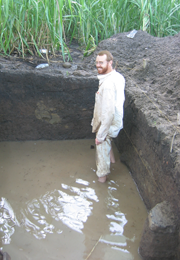Wes Stoner
Ph.D. Student
by Jessica Fisher
For many of us, when we think of an anthropologist we envision a lovesick hero retrieving artifacts from pillagers while simultaneously running from federal agents, all the while dodging villains in exotic places, and of course the inevitable tumble into a deadly snake pit. Though we may have Spielberg to thank for such stereotypes and the inclusion of anthropology into mainstream (however misleading Indiana Jones is as an archeologist), what he always leaves out is the immeasurable amount of hours anthropologists spend studying, teaching and in many cases trying to secure money for their research.
 Perhaps, the latter is less romantic than Hollywood’s spin, but for Wes Stoner, an Anthropology Ph.D. candidate at the University of Kentucky, it has been those grueling hours spent behind a computer that enabled his doctoral research on applying neutron activation analysis on ceramics. It is a rare glimpse into the history of pre-Hispanic Mesoamerica and there is absolutely nothing unromantic when passion mixed with meaningful research culminates into one’s life work.
Perhaps, the latter is less romantic than Hollywood’s spin, but for Wes Stoner, an Anthropology Ph.D. candidate at the University of Kentucky, it has been those grueling hours spent behind a computer that enabled his doctoral research on applying neutron activation analysis on ceramics. It is a rare glimpse into the history of pre-Hispanic Mesoamerica and there is absolutely nothing unromantic when passion mixed with meaningful research culminates into one’s life work.
Not to say that Stoner hasn’t experienced the pure excitement of working in the field. On the contrary, his dissertation took him to southern Veracruz, Mexico, where, he spent six months hiking through tropical jungles (minus the poisonous snakes) and had the incredible opportunity to interact with local people.
In fact, he undertook a pedestrian survey of the Tepango River valley in the Tuxtla Mountains to investigate more than 3,000 years of pre-Hispanic settlement from 1500 B.C. until Spanish contact. Under Stoner’s direction he conducted an intervalley comparison to provide insight on the "complex processes that local groups negotiate when faced with broader regional and interregional cultural influences."
"It was an area providing geographical variability to collect data on political, economic, and social organization that could be systematically compared to the better known pre-Hispanic occupation in the Catemaco Valley to the east," Stoner said of his field work. "Matacapan, the capital of the Catemaco Valley political system, displayed a well established connection with the central Mexican city of Teotihuacan during the Early and Middle Classic periods (300-650 A.D.). Totocapan, the capital of the Tepango Valley political system, did not display such a foreign connection."
In the beginning, Stoner, like many college students found choosing a major to be a matter of adaptation. From chemical engineering to psychology, Stoner’s interests and major took a final transformation during a Mesoamerican Archeology class, while the Lancaster, Pa., native was pursuing his undergraduate degree at Penn State University.
Stoner’s advisor at Penn State and Mesoamerican professor, Ken Hirth, suggested the Graduate Anthropology Program at the University of Kentucky as the home for Stoner’s higher education. It didn’t take long for Stoner to discover UK’s very own Christopher Pool, an established and well-known archeologist in Mesoamerica, solidifying his choice to come to UK.
Archaeology (a sub-discipline of anthropology) deals with material that past populations leave behind and that survive over time. For this reason, Stoner said, "I am interested in chemical and mineralogical analyses of artifacts. By deriving a chemical fingerprint for an artifact and comparing it to raw materials or other artifacts at the geological or production sources, archaeologists can make visible certain economic production and exchange relationships that otherwise remain invisible without written records."
Stoner obtained his master’s degree from UK in anthropology in 2003. Based on his knowledgeable and helpful pool of teachers, coupled with very diverse research, fieldwork, and teaching opportunities, which Stoner said "is pretty rare for anthropology departments across the country," he chose to continue on with his doctorate at UK.
 Initially, Stoner hadn’t planned on studying the chemistry of ancient ceramic pots in Mesoamerica, until Pool approached him with a conundrum in the archeological record. At the site in Matacapan, the production of a ceramic ware (Coarse Orange jars) had been unveiled, yet the purpose of these vessels remained unknown. Were they used at the site for storing grains and water or were they exchanged to other sites throughout the Tuxtlas region? The missing link intrigued Stoner and provided the launching pad for his research. In order to test theses different theories, Stoner applied "compositional sourcing analysis, which looks at the composition of archeological material and attempts to identify its geological or cultural source. This, in turn, can also facilitate an understanding of how powerful polities (i.e., Teotihuacan) spread their influence outward," Stoner said.
Initially, Stoner hadn’t planned on studying the chemistry of ancient ceramic pots in Mesoamerica, until Pool approached him with a conundrum in the archeological record. At the site in Matacapan, the production of a ceramic ware (Coarse Orange jars) had been unveiled, yet the purpose of these vessels remained unknown. Were they used at the site for storing grains and water or were they exchanged to other sites throughout the Tuxtlas region? The missing link intrigued Stoner and provided the launching pad for his research. In order to test theses different theories, Stoner applied "compositional sourcing analysis, which looks at the composition of archeological material and attempts to identify its geological or cultural source. This, in turn, can also facilitate an understanding of how powerful polities (i.e., Teotihuacan) spread their influence outward," Stoner said.
Based on Stoner’s research the Coarse Orange jars showed that "Matacapan exchanged these vessels throughout the Tuxtlas region, including Totocapan. Therefore, while Totocapan and Matacapan may have competed politically, they cooperated on an economic level. Second, this evidence of economic cooperation is corroborated by the fact that both urban centers grew and declined in synchronization throughout the Classic period, suggesting their fates were intertwined," Stoner said.
As Stoner pointed out "most materials archeologists study are created by hand so they contain certain cultural inputs and styles that are passed on from generation to generation or appropriated from other cultures."
Which makes you wonder, what will be our cultural input? More importantly, who will play Wes Stoner?
photos courtesy of Wes Stoner
